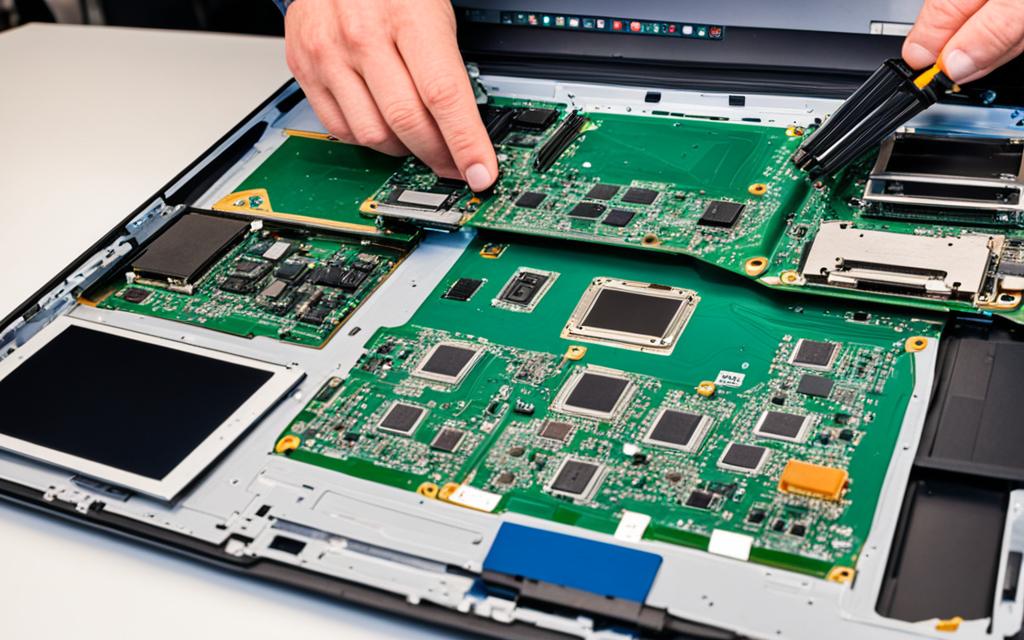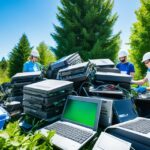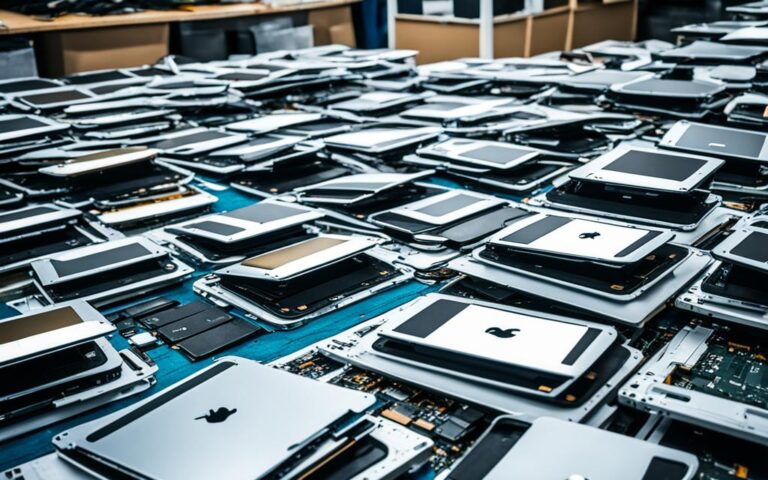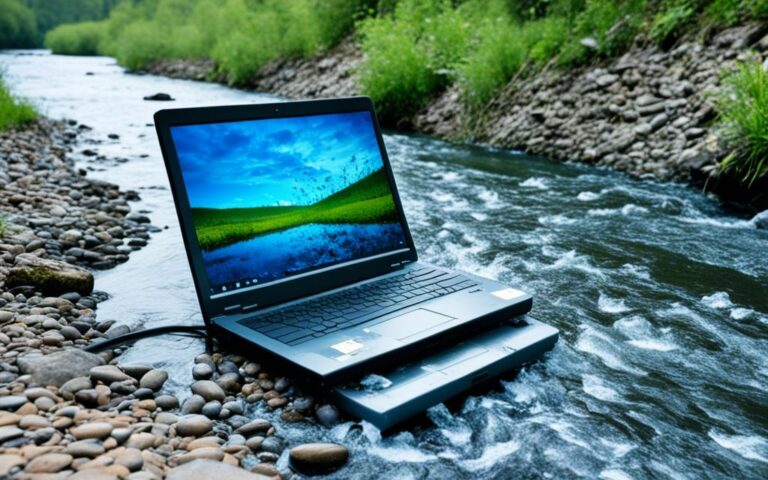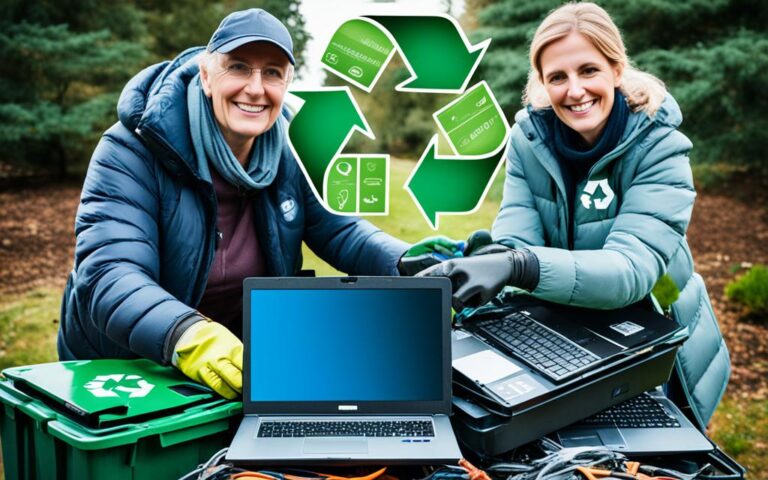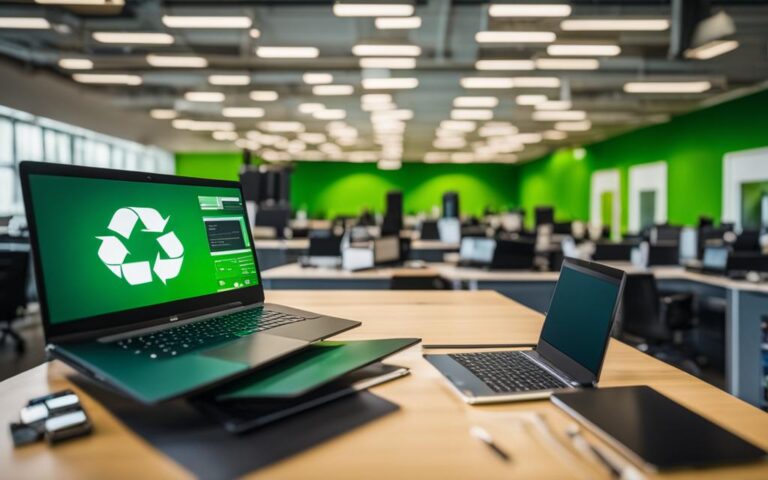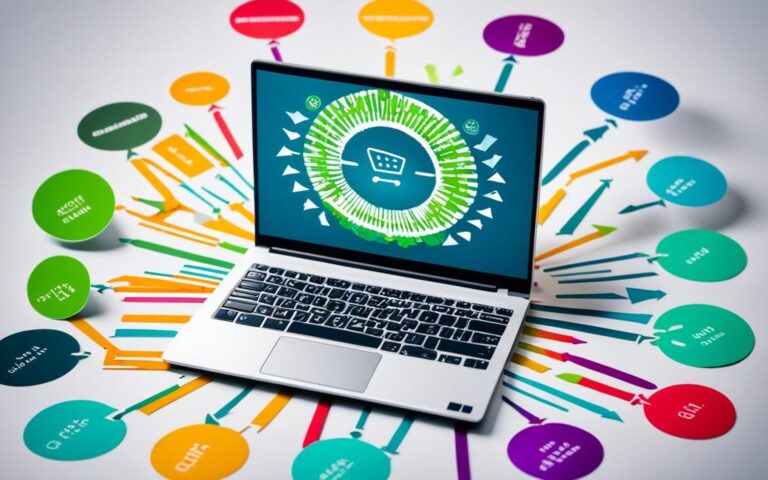Transforming E-Waste: The Journey of a Recycled Laptop
Electronic waste, or e-waste, is a significant problem caused by the disposal of millions of devices each year. These abandoned devices, including laptops, contain toxic materials that can harm the environment and human health. Recycling these laptops is crucial to mitigate these impacts and promote sustainability.
In this article, we will explore the transformative journey of a recycled laptop and the stages of the laptop recycling process. From the initial collection of e-waste to the final recycling of valuable materials, this journey showcases the positive impact of laptop recycling and highlights the importance of responsible disposal.
Throughout the article, we will delve into the typical lifecycle of a laptop, the detailed steps involved in the laptop recycling process, and the challenges faced in this endeavor. Additionally, we will discuss e-waste regulations and policies that play a vital role in promoting sustainable practices and reducing the amount of electrical waste.
Join us in this exploration of the laptop recycling process as we navigate the complexities of transforming e-waste into a greener future. Discover how you can contribute to the reduction of e-waste and embrace the responsibility of laptop recycling to create a sustainable and eco-friendly tech ecosystem.
The Typical Lifecycle of a Laptop
The lifecycle of a computer encompasses several stages: mining, manufacturing, packaging, shipping, usage, and recycling. Each stage plays a crucial role in the overall journey of a laptop, impacting its environmental footprint and sustainability.
Mining
In the mining stage, various metals such as silica, iron, copper, and lead are extracted from the earth. These non-renewable resources serve as the building blocks of a computer. However, mining activities can have significant environmental consequences, including habitat destruction and water pollution.
Manufacturing
During the manufacturing phase, the extracted metals and other components are transformed into a fully functional laptop. This process involves energy-intensive operations, contributing to carbon emissions and energy consumption. Additionally, the manufacturing process may require the use of hazardous materials, which need careful handling and disposal.
Packaging and Shipping
Once the laptops are manufactured, they are packaged and shipped to end-users. Packaging materials, such as cardboard and plastics, contribute to waste generation and environmental degradation. Moreover, shipping the laptops to various destinations incurs carbon emissions, especially if long distances are involved.
Usage
During the usage stage, individuals and organizations utilize laptops for various tasks such as work, entertainment, and communication. However, the usage phase also contributes to the laptop’s environmental impact, primarily through energy consumption and electronic waste generation. Energy-efficient practices, such as turning off the laptop when not in use and using power-saving settings, can help reduce the environmental footprint.
Recycle
When a laptop reaches the end of its lifespan or becomes obsolete, proper recycling becomes necessary. Recycling involves the extraction and recovery of valuable materials from the laptop, including precious metals like gold and silver, as well as recyclable components like plastics and glass. By recycling laptops, we can reduce the demand for new resources, minimize waste, and mitigate the environmental impact of electronic devices.
Recycling laptops is crucial for minimizing electronic waste and promoting sustainability.
The Computer Recycling Process
The computer recycling process entails several stages that ensure the proper disposal and reuse of old laptops and computers. By following these stages, we can minimize environmental impact and promote sustainability.
Collection and Transportation
The first stage of the computer recycling process involves the collection and transportation of old laptops and computers to designated recycling facilities. Various methods, such as recycling bins and pick-up services, are employed to facilitate the collection process. This ensures that these electronic devices do not end up in landfills, where they can pose significant environmental risks.
Sorting and Categorization
Once collected, the laptops undergo a thorough sorting and categorization process. This involves organizing the devices based on their type, model, and condition. Certified recyclers ensure data safety during this phase, guaranteeing that any sensitive information on the devices is properly handled and destroyed before further processing.
Dismantling and Disassembly
The next stage is the meticulous dismantling and disassembly of the laptops. Skilled technicians carefully separate valuable materials such as plastic casings, circuit boards, and metal components. This step ensures that these materials can be reused or recycled, reducing the need for new resources and minimizing waste. Hazardous materials, such as batteries and toxic substances, are also identified and separated for safe disposal.
Recycling
Once the laptops have been disassembled and the various components have been separated, the recycling stage begins. Valuable materials, such as metals like copper, aluminum, and steel, are melted down and recycled for use in new products. Glass components are extracted for glass manufacturing, while non-recyclable materials can be converted into energy through waste-to-energy incineration. This comprehensive recycling process ensures that as much of the laptop as possible is repurposed or reused, minimizing environmental impact and promoting a circular economy.
The computer recycling process is crucial in managing electronic waste and reducing the environmental footprint of discarded laptops. By collecting and transporting old devices to recycling facilities, sorting and categorizing them, and appropriately dismantling and recycling their components, we can contribute to a more sustainable future.
E-Waste Regulations and Policies
E-waste regulations and policies play a crucial role in promoting sustainable practices and reducing the amount of electrical waste. In the UK, the Waste Electrical & Electronic Equipment (WEEE) Regulations have been implemented to set annual targets for the recycling of all waste electricals. These regulations aim to minimize landfill waste and ensure that procedures and retailers comply with recycling obligations. By adhering to these regulations, the UK can effectively reduce the environmental impact of e-waste and promote a circular economy.
| Benefits of E-Waste Regulations and Policies: |
|---|
| – Reduction of landfill waste and associated environmental pollution |
| – Conservation of valuable resources through recycling |
| – Promotion of a sustainable and circular economy |
| – Compliance and accountability of procedures and retailers |
With the implementation of the WEEE Regulations, the UK has achieved significant progress in the management of e-waste. It has established recycling targets for waste electrical and electronic equipment (WEEE) and encouraged responsible disposal and recycling practices. These targets ensure that a certain percentage of e-waste is properly recycled each year, reducing its harmful impact on the environment and human health.
By setting recycling targets, the WEEE Regulations promote the proper collection, treatment, and recycling of e-waste. Retailers and producers are required to provide systems for the free disposal of old electricals when purchasing new devices. Additionally, recycling facilities are obligated to adhere to strict environmental standards and data protection regulations to ensure the safe handling of e-waste.
Meeting recycling targets not only reduces the environmental impact of e-waste but also enables the recovery of valuable materials such as gold, silver, copper, and rare earth metals. These materials can be reused in the production of new electronic devices, reducing the need for virgin resources and conserving energy. It also creates employment opportunities, promotes technological innovation, and contributes to the circular economy.
The Importance of E-Waste Recycling Targets
“The WEEE Regulations and their recycling targets are vital for managing e-waste effectively. By encouraging responsible disposal and recycling practices, we can protect our environment, conserve valuable resources, and promote a sustainable future.”
– [Name], Environmental Specialist at [Company]
Meeting recycling targets under the WEEE Regulations requires collaboration between government bodies, recycling facilities, retailers, manufacturers, and consumers. It is essential for individuals to participate in proper e-waste disposal by utilizing designated collection points or arranging for pickup services. By doing so, they contribute to the achievement of recycling targets and the reduction of e-waste pollution.
Furthermore, public awareness campaigns play a significant role in educating consumers about e-waste hazards and the importance of recycling. These campaigns help increase citizen engagement, promoting a culture of responsible e-waste management and recycling.
Overall, the implementation of e-waste regulations and policies, such as the WEEE Regulations with its recycling targets, is essential for effectively managing the growing problem of e-waste. It not only helps protect the environment but also ensures the sustainable use of resources and the long-term health of our planet.
Challenges in Laptop Recycling
The process of laptop recycling poses several challenges, which must be addressed to ensure the success of recycling initiatives and promote a sustainable future. These challenges include:
-
Lack of Consumer Awareness
One significant challenge is the lack of consumer awareness regarding the importance of computer recycling and the dangers of e-waste. Many consumers are unaware of the negative environmental and health impacts caused by improperly disposing of electronic devices. Educational events and awareness campaigns can play a crucial role in educating consumers and encouraging responsible recycling practices.
-
Short Life Cycle of New Devices
Another challenge in laptop recycling is the relatively short lifespan of new devices. With rapid technological advancements, consumers frequently upgrade to newer models, rendering their old laptops outdated. This short life cycle makes it challenging to market recycled products, as the demand for older models diminishes quickly. Finding innovative ways to extend the lifespan of electronic devices or repurposing recycled components is crucial to address this challenge.
-
Time-consuming and Labor-intensive Processes
Laptop recycling involves time-consuming and labor-intensive processes that require specialized equipment and expertise. Disassembling laptops to extract valuable materials and separate hazardous components is a meticulous process. Furthermore, ensuring data security during the recycling process adds another layer of complexity. The overall recycling process is resource-intensive and requires skilled workers to handle hazardous materials safely.
Overcoming these challenges is imperative to promote consumer awareness, optimize the recycling process, and reduce the environmental impact of e-waste. By addressing these challenges, we can establish a culture of responsible electronic waste management and contribute to a sustainable future.
Challenges in Laptop Recycling
| Challenges | Description |
|---|---|
| Lack of Consumer Awareness | Consumers are often unaware of the importance of computer recycling and the dangers of e-waste, leading to improper disposal of electronic devices. |
| Short Life Cycle of New Devices | The rapid technological advancements result in shorter lifespans of new devices, making it challenging to market recycled products. |
| Time-consuming and Labor-intensive Processes | Laptop recycling involves meticulous disassembly, data security measures, and specialized handling of hazardous materials, making it a time-consuming and labor-intensive process. |
The image above illustrates the short life cycle of new devices, further emphasizing the challenge faced in the laptop recycling process. The alt attribute of the image relates to the keyword “Short Life Cycle of New Devices”.
Conclusion
The journey of a recycled laptop is a transformative process that plays a vital role in reducing e-waste and promoting sustainability. By following the stages of the laptop recycling process and adhering to e-waste regulations and policies, we can actively contribute to a greener future.
Laptop recycling not only prevents the disposal of laptops in landfills but also helps to conserve valuable resources and minimize the environmental impact of electronic devices. By responsibly recycling laptops, we can support the development of a circular economy where materials are reused and repurposed, reducing the need for new production.
Let us embrace the responsibility of laptop recycling and actively participate in reducing e-waste. Together, we can create a sustainable and eco-friendly tech ecosystem that benefits both the environment and future generations.
FAQ
What is e-waste?
E-waste, or electronic waste, refers to the disposal of electronic devices such as laptops, which can be harmful to the environment and human health due to their toxic materials.
Why is laptop recycling important?
Laptop recycling is crucial because it helps reduce the environmental impact of e-waste and promotes sustainability by extracting valuable materials and reducing the need for new resources.
What are the stages of the laptop recycling process?
The laptop recycling process involves collection and transportation, sorting and categorization, dismantling and disassembly, and finally, recycling the disassembled components to extract valuable materials.
How are old laptops collected for recycling?
Old laptops can be collected for recycling through various methods such as recycling bins and pick-up services provided by recycling facilities.
What happens to old laptops during recycling?
During the recycling process, old laptops undergo sorting and categorization based on device type, model, and condition. They are then dismantled and disassembled, with valuable materials separated and hazardous materials identified for proper handling. Finally, the disassembled components are recycled by melting metals and extracting glass for new product manufacturing.
What are e-waste regulations and policies?
E-waste regulations and policies, such as the Waste Electrical & Electronic Equipment (WEEE) Regulations in the UK, set annual recycling targets for waste electricals to minimize landfill waste and ensure compliance with recycling obligations.
What are the challenges in laptop recycling?
Challenges in laptop recycling include lack of consumer awareness about the importance of recycling and the dangers of e-waste, the short lifespan of new devices making it difficult to market recycled products, and the need for specialized equipment and expertise to handle hazardous materials.
How does laptop recycling contribute to sustainability?
Laptop recycling contributes to sustainability by preventing laptops from ending up in landfills, conserving valuable resources through the extraction of materials, and supporting the development of a circular economy.

